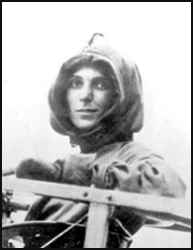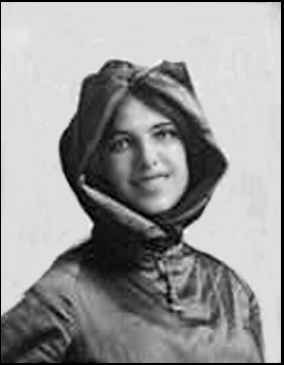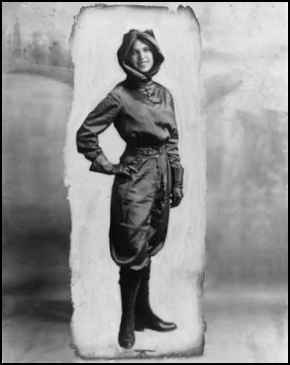
1875-1912 |
 |
 |
 |
 |
 |
||
| Biography | Gallery | Resources | Additional Resources |
|
Information from Dwight R. Messimer, 3-27-05. I was working on my Paul Beck project when I came across your page on Harriet Quimby, and thought that you might be able to use some details for the In Memorium section. The connection with Paul Beck is that he also flew in the unsanctioned Boston Air Meet during the first week in July 1912. The ACA suspended Beck, and the other twelve fliers who took part, including Lincoln Beachy, though the sanction against Harriet was meaningless. Anyway She died Friday evening, 1 July 1912 while making a practice flight from Harvard Field, across Dorchester Bay to Boston Light, and back. She was scheduled to make the 20-mile flight on Saturday 2 July in an attempt to set a record. Her aircraft was a two-seat Blériot XI and on the evening of 1 July she carried William A. P. Willard as her passenger. Whether or not they were strapped in is an ongoing debate, but inasmuch as they both fell out of the airplane, it appears that they were not strapped in. In any event, the flight went well out and back, but as she approached Harvard Field and started her descent to land, the plane pitched forward and catapulted Willard into space. The plane then went vertical and Harriet came out of the cockpit too. The accident occurred just after 8 PM at about 1,000 feet. What happened? As with previous models, the Blériot XI featured a horizontal stabilizer that was actually a lifting surface. It made the aircraft unstable to the point that Harriet had routinely carried ballast in the tail section. Apparently, as she nosed down, Willard was either pitched forward or he rose up in his seat to say something to Harriet. Whatever happened, his movement shifted the center of gravity forward and the plane nosed down sharply, throwing Willard out. An expert explained what happened next: "Without Willard's weight in the rear seat the lift on the tail increased as the diving airplane gained speed until a critical moment was reached at which it was impossible to get the tail down though the elevator stick was pulled back. The faster the machine dives, the more lift the tail provides until it has the plane in a vertical position, hurling the pilot and passenger out." [August 1912 issue of Aircraft Magazine] The Best to you, Dwight R. Messimer |
|
Contributed by Pete Jones, 7-21-10 |
|
If you have any more information on this pioneer aviator please contact me. E-mail to Ralph Cooper |


|